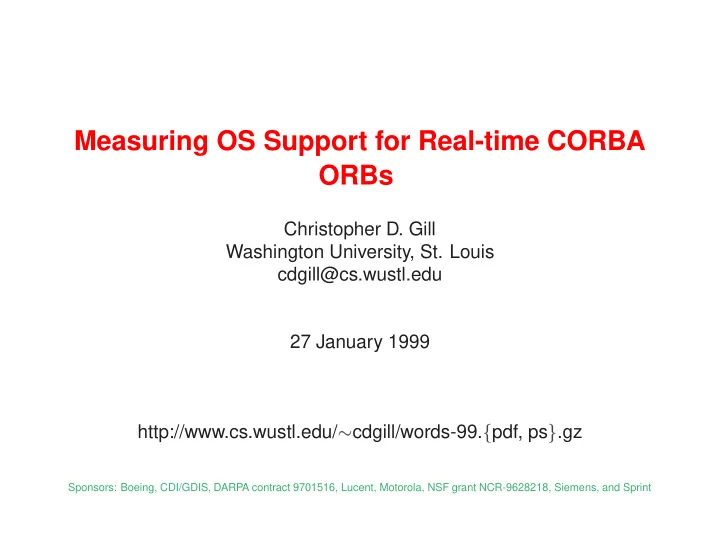

Measuring OS Support for Real-time CORBA ORBs Christopher D. Gill Washington University, St. Louis cdgill@cs.wustl.edu 27 January 1999 http://www.cs.wustl.edu/ � cdgill/words-99. f pdf, ps g .gz Sponsors: Boeing, CDI/GDIS, DARPA contract 9701516, Lucent, Motorola, NSF grant NCR-9628218, Siemens, and Sprint
Christopher D. Gill Real-Time ORBs Advantages of CORBA � Goals of CORBA ��� ��������� ��� �������������� ��������� �������������� ���������� �������� ���������� ���������� �������� ���������� – Simplify distribution �������� ������ ����������� ����������� by automating ������ ��� � ������� � ��� ������������������������� � Object location and activation ��� �������� ��� � Parameter ��� ��� ��� ��� ������ ����� ����� ��������� ������� marshaling � Demultiplexing ���� � � ���� ���� � � ������ ����� ��� ������ ���� ���� ������ � Error handling ������������������� ��������������������������� – Provide foundation ���� ������������������� ������������������ for higher-level www.cs.wustl.edu/ � schmidt/ services ORB-endsystem.ps.gz Washington University, St. Louis 1
Christopher D. Gill Real-Time ORBs Limitations of CORBA for Real-time Systems � Limitations �������� �������� � � ����������� ����������� ������ ������ ������ ������ � ������� � ������� � � ������������������������� ������������������������� – Lack of QoS specifications � � ��� ��� � � – Lack of QoS �������� �������� ��� ��� ��� ��� ������ ������ enforcement � � ����� ����� ������� ������� ��������� ��������� – Lack of real-time ��� ��� ���� � � ���� ���� ���� programming ���� ���� � � features ���������� ���������� ���������� ���������� � � – Lack of ����� � � ������������ ����� � � ������������ ����� ������������ ����� ������������ � � performance ������������������� ������������������� ������������������� ������������������� ������� ������� � � optimizations �� ������������������� �� �������������������� �� ��������������������������� �� ��������������������� �� ���������������� �� ��������������������� �� ��������������������������� �� ������������������ Washington University, St. Louis 2
Christopher D. Gill Real-Time ORBs But Can It Perform? � Low overhead – context switch time – request-response latency – ORB/endsystem CPU overhead � Elimination of priority inversion – context switch time – request-response latency � Predictability – request-response jitter � Footprint Washington University, St. Louis 3
Christopher D. Gill Real-Time ORBs Context Switch Time Measurements Operating Context Switch Time, � sec System mean (standard deviation) Suspend- Yield Test Synch Test Resume Test VxWorks 0.946 (0.041) N/A 1.62 (0.023) LynxOS N/A 5.42 (0.008) 5.96 (0.042) Windows NT 1.41 (0.036) 1.78 (0.021) 2.79 (0.110) Solaris 21.3 (0.569) 11.2 (0.900) 131.2 (0.613) Linux N/A 2.60 (0.023) 9.72 (0.187) Table 1: Context Switch Time Measurements Washington University, St. Louis 4
Christopher D. Gill Real-Time ORBs Context Switch Time Measurements � Measured two context switches for two-way CORBA operation, as expected � Contribution of context switch time, 1 to 10 � sec, to latency is small � Standard deviations are small, except on Solaris, where it may impair performance predictability Washington University, St. Louis 5
Christopher D. Gill Real-Time ORBs Priority Inversion Experiments � One high-priority client Servants [P ] [P ] [P ] [P ] SCHEDULER RUNTIME 0 1 2 3 Object Adapter � 1..n low-priority clients [P ] [P ] [P ] [P ] 0 1 2 3 C 0 C C C 3 1 2 � Server factory S S S 2 S 0 1 3 ORB Core Requests implements Priority [P] thread-per-connection I/O SUBSYSTEM Client Server – Higher real-time priority for high-priority client �� �� �� �� �� �� �� � – Lower real-time �� Pentium II priority for all low-priority clients � Each connection links client with its servant Washington University, St. Louis 6
Christopher D. Gill Real-Time ORBs ORB Latency and Priority Inversion Results 1200 � Synopsis of results 20 Hz 10 Hz 5 Hz 1 Hz – LynxOS and Linux 1000 Two-way Request Latency, usec provide lowest latency – LynxOS and VxWorks 800 do not exhibit priority inversion; non-RTOS’s 600 do 400 – Therefore, deterministic QoS 200 support requires a RTOS 0 Linux LynxOS NT Solaris VxWorks Operating System Washington University, St. Louis 7
Christopher D. Gill Real-Time ORBs ORB Jitter Results 600 � Definition 20 Hz 10 Hz 5 Hz 1 Hz – Standard deviation 500 from average latency Two-way Request Jitter, usec 400 � Synopsis of results 300 – LynxOS and VxWorks show low jitter 200 – Linux, Windows NT, and Solaris show 100 unacceptable jitter 0 Linux LynxOS NT Solaris VxWorks Operating System Washington University, St. Louis 8
Christopher D. Gill Real-Time ORBs Future Work � Latency and jitter measurements – LynxOS offers low latency and jitter (high predictability) – VxWorks does also, with small number of low-priority clients; but does not scale well – Non-RTOS’ have high latency and/or jitter � ORB/OS operation throughput – Fairly consistent results across platforms � ORB/OS CPU processing overhead – Ranges from under 3 percent (Windows NT) to over 17 percent (VxWorks) Washington University, St. Louis 9
Christopher D. Gill Real-Time ORBs Concluding Remarks � We can meet RT performance goals with CORBA, on RTOS’. � Design and Implementation Challenges – Dynamic and hybrid scheduling of requests and operations – Specifying QoS requirements – Distributed QoS and integration with real-time I/O Subsystems – Alleviating priority inversion and non-determinism – Reducing latency/jitter for demultiplexing – Reducing presentation layer overhead – Optimizing IDL compilers – Maintaining small footprint Washington University, St. Louis 10
Christopher D. Gill Real-Time ORBs For Further Information � Performance Measurements: – Demultiplexing latency: www.cs.wustl.edu/ � schmidt/GLOBECOM-97.ps.gz – SII throughput: www.cs.wustl.edu/ � schmidt/SIGCOMM-96.ps.gz – DII throughput: www.cs.wustl.edu/ � schmidt/GLOBECOM-96.ps.gz – Latency, scalability: www.cs.wustl.edu/ � schmidt/ICDCS-97.ps.gz – IIOP: www.cs.wustl.edu/ � schmidt/IIOP.ps.gz Washington University, St. Louis 11
Christopher D. Gill Real-Time ORBs For Further Information � More detail on TAO: www.cs.wustl.edu/ � schmidt/RT-ORB.ps.gz � TAO Event Channel: www.cs.wustl.edu/ � levine/research/JSAC98.ps.gz � TAO static scheduling: www.cs.wustl.edu/ � schmidt/TAO.ps.gz � TAO dynamic scheduling: www.cs.wustl.edu/ � levine/research/scheduling/dynamic.pdf � ORB Endsystem Architecture: www.cs.wustl.edu/ � schmidt/RT-middleware.ps.gz Washington University, St. Louis 12
Christopher D. Gill Real-Time ORBs For Further Information � More detail on CORBA: www.cs.wustl.edu/ � schmidt/corba.html � ADAPTIVE Communication Environment (ACE): www.cs.wustl.edu/ � schmidt/ACE.html � The ACE ORB (TAO): www.cs.wustl.edu/ � schmidt/TAO.html � These slides: f pdf, ps g .gz www.cs.wustl.edu/ � cdgill/words-99. Washington University, St. Louis 13
Recommend
More recommend